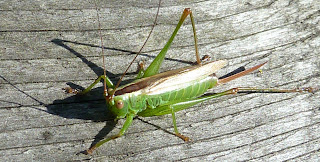 |
| cepaea nemoralis |
 |
| Marsh Frog |
Magpie and wood pigeon were perched in the trees and a great spotted wood pecker was calling in the distance. In the sheltered area we managed to see blue tit, great tit and a chiffchaff. As we continued into the more open area a kestrel hovered overhead and a sparrowhawk flew through. We heard a wren and cetti's warbler. A gang of about 8 swallows flew through over the pools and towards the Thames.
 |
| Hole in Reedmace Stem |
 |
| Tunnelling inside the stem |
Continuing our walk on the wooden boarding between the reed beds we noticed several dragonflies including ruddy darter. A large flock of starling were disturbed by a peregrine stooping. From the viewpoint we added lapwing, pochard, tufted duck and little grebe.
Looking out over the fields at the far end of the reserve there were large numbers of gulls including herring, greater & lesser black-backed, and black-headed. They were joined by jackdaw and carrion crow.
As Malcolm and I moved ahead of Sally and Irene there was a loud screaming of a water rail from under the boardwalk just ahead of us - quite a scary experience! Further along we had very close views of lizard, marsh frog, devils coachman with it's raised "scorpion" tail.
 |
| Devil's Coachman |
As we had heard that there might be whinchat beyond the reserve near the base of the landfill site we continued along the path outside the reserve. Although the whinchat eluded us we did see a large flock of goldfinch feeding on teasel heads, and peacock, red admiral, and small white butterflies. A female long-winged conehead was very obliging whilst we took photos, and then a little later we also saw a male.
 |
| female long-winged conehead |
From the path we had great views over the reserve and on a mound near the new hide there was a wheatear in usual pose, after we had spent several minutes enjoying it, we moved off towards the car park, arriving just before 5.00 pm when they were due to close, and got back to Gravesend in record time.
 |
| Wheatear |
No comments:
Post a Comment